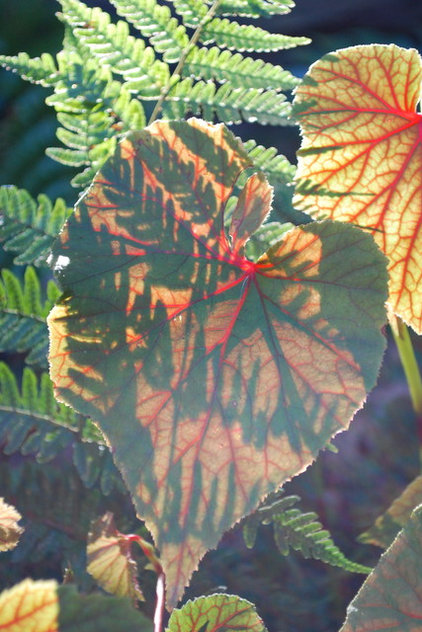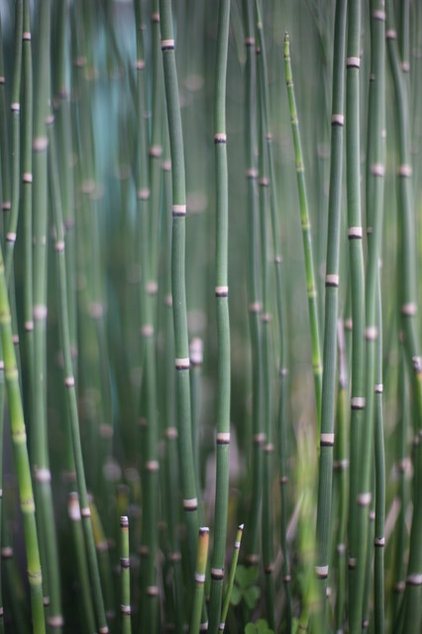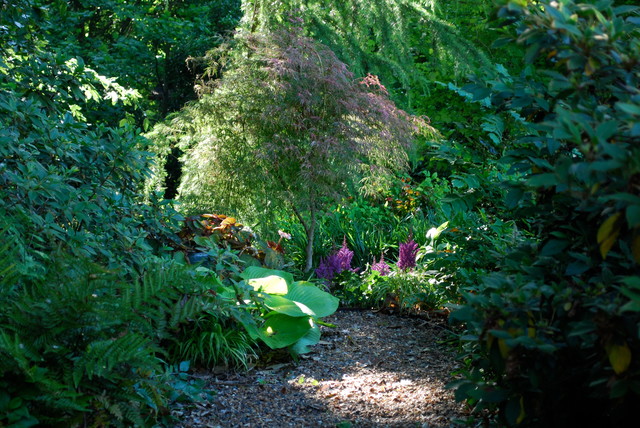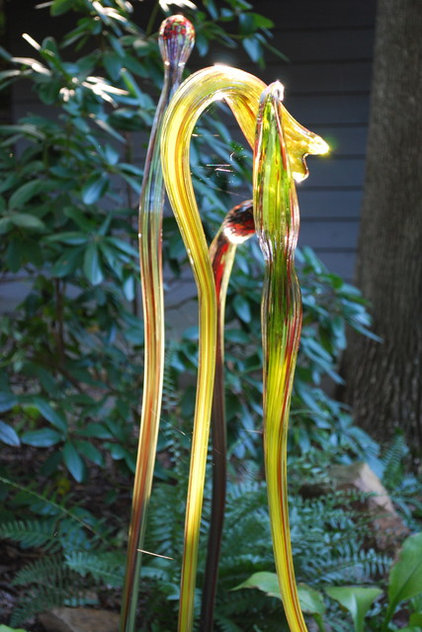People seem to want what they seemingly can't have. Folks with straight hair want curly hair. Those with curly hair want straight hair. Shade gardeners want more sun. Sun gardeners want more shade. My personal garden resides in partial to full shade. Over the years I have celebrated it, cursed it, embraced it and tweaked it. My landscape has gone through this process with me, indulging me, being patient with me and occasionally fighting back at me. Finally, my Gainesville, Fla landscape is all the better for it, as am I. We are at peace.
Allow me to take you on my journey. If your landscape is a shade garden, I believe that I can save you time, money and frustration. Let's take a walk and have that conversation.
 Add to ideabook
by Jay Sifford Garden Design
Take inventory of how light plays in your garden. As most gardeners realize, a truly great personalized garden takes time to develop. This type of landscape is no one-weekend DIY project, no matter what television commercials preach to us. A great landscaper is one who has developed a keen sense of observation. An experienced gardener knows that the sun hits his or her garden differently at different times of year, that the intensity of the sun ebbs and flows with the seasons, and that the color of sunlight changes with its intensity.
Add to ideabook
by Jay Sifford Garden Design
Take inventory of how light plays in your garden. As most gardeners realize, a truly great personalized garden takes time to develop. This type of landscape is no one-weekend DIY project, no matter what television commercials preach to us. A great landscaper is one who has developed a keen sense of observation. An experienced gardener knows that the sun hits his or her garden differently at different times of year, that the intensity of the sun ebbs and flows with the seasons, and that the color of sunlight changes with its intensity.On the edge of my Gainesville pond, beside the largest waterfall, is a flat boulder that I affectionately call my "wine rock." I sit there in the mornings with coffee or in the afternoon with a good malbec, watch the koi and reflect on life.
I took this picture one day in late spring, when the morning sun appeared through the trees and perfectly choreographed the interactive dance between the hardy begonia (Begonia grandis, zones 6 to 9) and the autumn fern (Dryopteris erythrosora, zones 5 to 9). This only happens for a few minutes each morning, but what a spectacular way to start the day. I wouldn't miss it.
 Add to ideabook
by Ron Yeo, FAIA Architect
Consider pruning, limbing up or removal to open up your space. A successfully executed garden is a collaboration between what the space has and what can thrive in that area. If you are having trouble in this area, don't hesitate to enlist the help of a good Gainesville landscape designer with whose work you are familiar.
Add to ideabook
by Ron Yeo, FAIA Architect
Consider pruning, limbing up or removal to open up your space. A successfully executed garden is a collaboration between what the space has and what can thrive in that area. If you are having trouble in this area, don't hesitate to enlist the help of a good Gainesville landscape designer with whose work you are familiar.Once you have a vision for the shape and scope your garden should take, you may find it necessary to prune, thin saplings or limb up your trees to create an environment that welcomes sunlight. If you're unable to handle the job, a local Gainesville Tree service can certainly give you a hand. You may also need to hire a good Gainesville arborist to remove trees that are detracting from the overall feel of your garden or inhibiting your sight lines. This sometimes requires fortitude, but your garden will thank you in the end.
 Add to ideabook
by Chicago Specialty Gardens, Inc.
Embrace the art of backlighting. Some of the more mundane plants in your garden will suddenly take on new vibrancy when placed in front of available light.
Add to ideabook
by Chicago Specialty Gardens, Inc.
Embrace the art of backlighting. Some of the more mundane plants in your garden will suddenly take on new vibrancy when placed in front of available light. Some of the most effective plants for this technique are those that are translucent by nature, those that capture and diffuse light.
My favorite translucent plant is the sometimes-invasive horsetail rush(Equisetum hyemale, zones 3 to 11). Its 3- to 4-foot upright growth habit is a perfect foil for a curved or rounded sculpture, or a clumping shrub. Just be sure to contain it, lest it spread indefinitely.
 Add to ideabook
by Jay Sifford Garden Design
Apart from backlighting an individual plant, you can backlight an entire garden scene. This photo shows a gorgeous Gainesville landscape in the shade. Who wouldn't want to return home to this after sitting in rush-hour traffic?
Add to ideabook
by Jay Sifford Garden Design
Apart from backlighting an individual plant, you can backlight an entire garden scene. This photo shows a gorgeous Gainesville landscape in the shade. Who wouldn't want to return home to this after sitting in rush-hour traffic?
 Add to ideabook
by Harold Leidner Landscape Architects
Capture reflections on water. Water features are great instruments to use in our quest for inviting light into our garden spaces. Water churns, bubbles, spills and cascades, all the while capturing light in ever-changing ways. A properly sited and designed Gainesville water feature can be a mesmerizing focal point.
Add to ideabook
by Harold Leidner Landscape Architects
Capture reflections on water. Water features are great instruments to use in our quest for inviting light into our garden spaces. Water churns, bubbles, spills and cascades, all the while capturing light in ever-changing ways. A properly sited and designed Gainesville water feature can be a mesmerizing focal point. I wholeheartedly recommend that you consult a landscape professional, and that you view his or her work in other gardens, before you design and install your pond. A poorly designed water feature will most assuredly be an expensive disappointment.
 Add to ideabook
by Jay Sifford Garden Design
Let light project onto a screen. Much like the drive-in movie theaters of the past, you can project light in your garden, capturing its movement and nuances, by erecting a screen or wall, or even by enlisting the side of your house. This three-paneled privacy screen, constructed out of concrete backer board like you would find underneath a tile floor, faces west and projects a virtual documentary of the afternoon sun. Who wouldn't want to watch this light show?
Add to ideabook
by Jay Sifford Garden Design
Let light project onto a screen. Much like the drive-in movie theaters of the past, you can project light in your garden, capturing its movement and nuances, by erecting a screen or wall, or even by enlisting the side of your house. This three-paneled privacy screen, constructed out of concrete backer board like you would find underneath a tile floor, faces west and projects a virtual documentary of the afternoon sun. Who wouldn't want to watch this light show?
 Add to ideabook
by Jay Sifford Garden Design
Add glass. Nothing captures, reflects and refracts light like glass. The pieces shown here were custom designed to mimic new shoots of plant growth and placed so that they rise from a sea of shade-loving ground cover.
Add to ideabook
by Jay Sifford Garden Design
Add glass. Nothing captures, reflects and refracts light like glass. The pieces shown here were custom designed to mimic new shoots of plant growth and placed so that they rise from a sea of shade-loving ground cover.One thing to consider before installing a glass sculpture in your garden is possible breakage from overhead limbs falling in inclement weather. Assess your budget and tolerance level for loss before purchasing your glass. If you decide to invest in aglass garden sculpture, you'll get shining rewards.
 Add to ideabook
by Margie Grace - Grace Design Associates
Create the illusion of light by using chartreuse foliage. The human eye generally reads sunlight as having a yellowish cast. You can introduce the illusion of light into a shade garden by introducing plants withchartreuse foliage. This photograph illustrates the principle brilliantly. Don't you almost want to squint when you view this photo? On a closer look, you realize that this is a shaded area, that the effect of sunlight is an illusion.
Add to ideabook
by Margie Grace - Grace Design Associates
Create the illusion of light by using chartreuse foliage. The human eye generally reads sunlight as having a yellowish cast. You can introduce the illusion of light into a shade garden by introducing plants withchartreuse foliage. This photograph illustrates the principle brilliantly. Don't you almost want to squint when you view this photo? On a closer look, you realize that this is a shaded area, that the effect of sunlight is an illusion.Pulling this illusion off successfully does require some skill, but here are some pointers to get you started.
- Begin by observing how shafts of sunlight pierce the tree canopy in your garden and the resulting shape on your garden floor. Is it an elongated triangle, a line or a patch?
- Leave your plants in their pots and arrange them in this pattern until the result is pleasing to you.
- Easier still, wait until the sunlight creates its unique shape on your garden floor, then trace the pattern with your potted plants.
Some of my favorite chartreuse-leafed plants for you to consider, taking into account your specific growing conditions:
- 'Sun Power' and 'Sum and Substance' hostas (Hosta cvs, zones 4 to 9)
- 'All Gold' and 'Aureola' Japanese forest grass (Hakonechloa macra cvs, zones 4 to 9)
- 'Orange Dream' Japanese maple (Acer palmatum 'Orange Dream', zones 5 to 9)
- Golden sweet flag (Acorus gramineus 'Ogon', zone 5 to 11)
- Scotch moss (Sagina subulata 'Aurea', zones 3 to 9)
- 'Skylands' Oriental spruce (Picea orientalis 'Skylands', zones 4 to 8)
Note that most plants with chartreuse foliage require at least several hours of sunlight to perform properly.
 Add to ideabook
by KG DESIGNS
Add plants with white flowers or variegated foliage. Nothing brightens a shade garden like white flowers and foliage. While white doesn't imitate sunlight quite as well as chartreuse, it is still very effective in giving the illusion of light. It is also particularly effective at dusk, when it seems to glow.
Add to ideabook
by KG DESIGNS
Add plants with white flowers or variegated foliage. Nothing brightens a shade garden like white flowers and foliage. While white doesn't imitate sunlight quite as well as chartreuse, it is still very effective in giving the illusion of light. It is also particularly effective at dusk, when it seems to glow.What's a shade garden without at least one hydrangea? Before buying your hydrangea, do some quick research on the types best suited for your location.
The oakleafs and mopheads are better suited for shade, while the paniculatas require sun to reach their blooming potential. 'Little Honey' (Hydrangea quercifolia 'Little Honey', zones 5 to 9) combines the best attributes for our discussion in that it can take shade or partial sun, and has chartruese foliage and white flowers. Another one of my favorites is 'Incrediball' (Hydrangea arborescens 'Abetwo', zones 3 to 9). Its nondrooping 12-inch flower heads are real showstoppers.
Some plants with variegated foliage for you to consider are bugloss (Brunnera macrophylla, zones 3 to 8), 'Patriot' hosta (Hosta 'Patriot', zones 3 to 8), 'River Mist' Northern sea oats (Chasmanthium latifolium 'River Mist', zones 4 to 9), and 'Floating Clouds' redbud (Cercis canadensis 'Floating Clouds', zones 5 to 9).
 Add to ideabook
by Possidento Lightscapes LLC
Invest in Gainesville landscape lighting. Nothing animates a garden quite like good-quality lighting. This spectacular photo says it all. There are a few things to consider before light installation. Do your research with regard to technology, annual utility cost, and fixture and bulb life.
Add to ideabook
by Possidento Lightscapes LLC
Invest in Gainesville landscape lighting. Nothing animates a garden quite like good-quality lighting. This spectacular photo says it all. There are a few things to consider before light installation. Do your research with regard to technology, annual utility cost, and fixture and bulb life. LED lighting has come a long way in just the last couple of years and is extremely cost effective over time. Buy the best-quality lighting you can afford. Cheaper lighting will end up costing you more in the long run, in terms of both replacements and energy use.
Most important, decide which focal points should be illuminated and which ones are better left to daylight. There is a fine line between just enough lighting and too much. Consider the seductive beauty of shadows and darkness to gain the most from lighting your garden.
I've seen way too many DIY lighting projects that end up looking like the Las Vegas strip. If you aren't gifted with an eye for design, please consider having your system designed and installed by a licensed landscape professional with whose work you are familiar.
